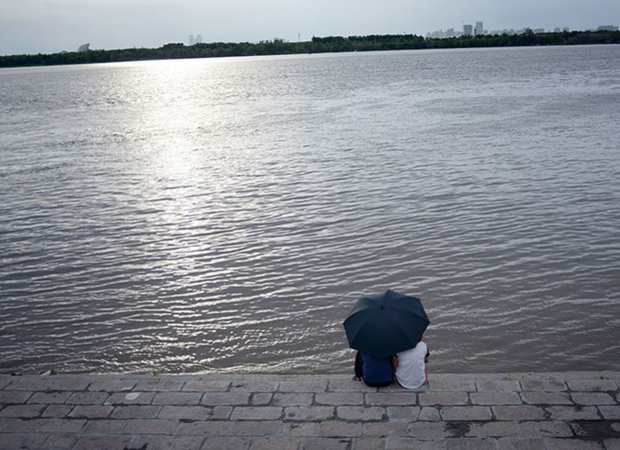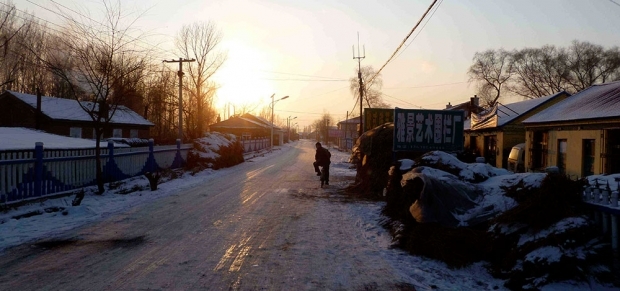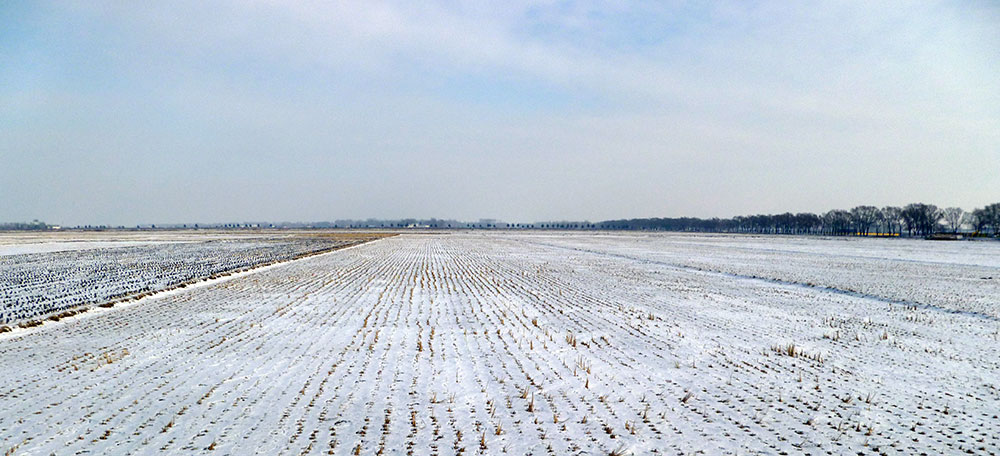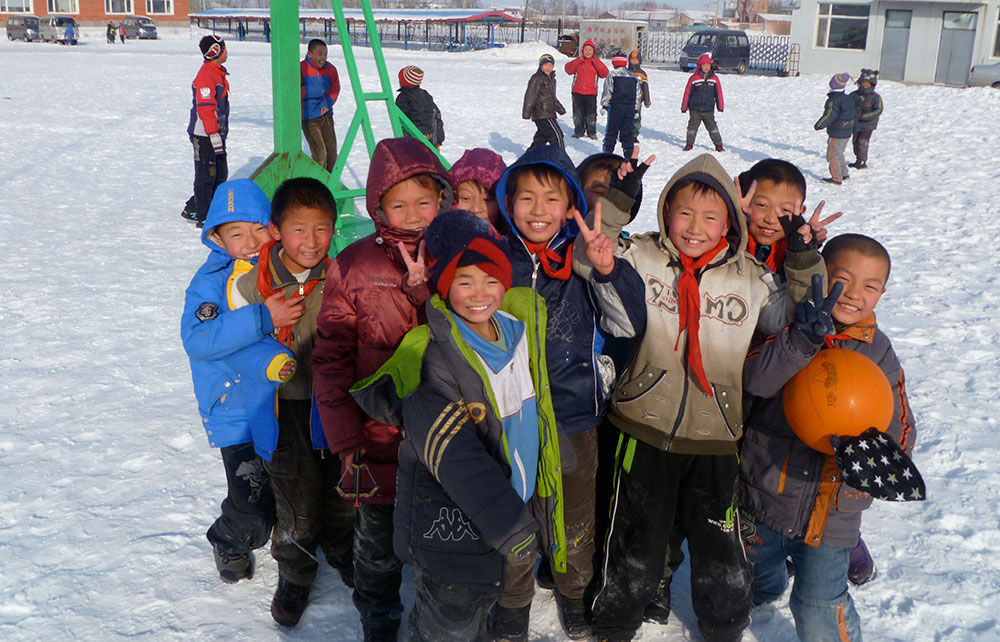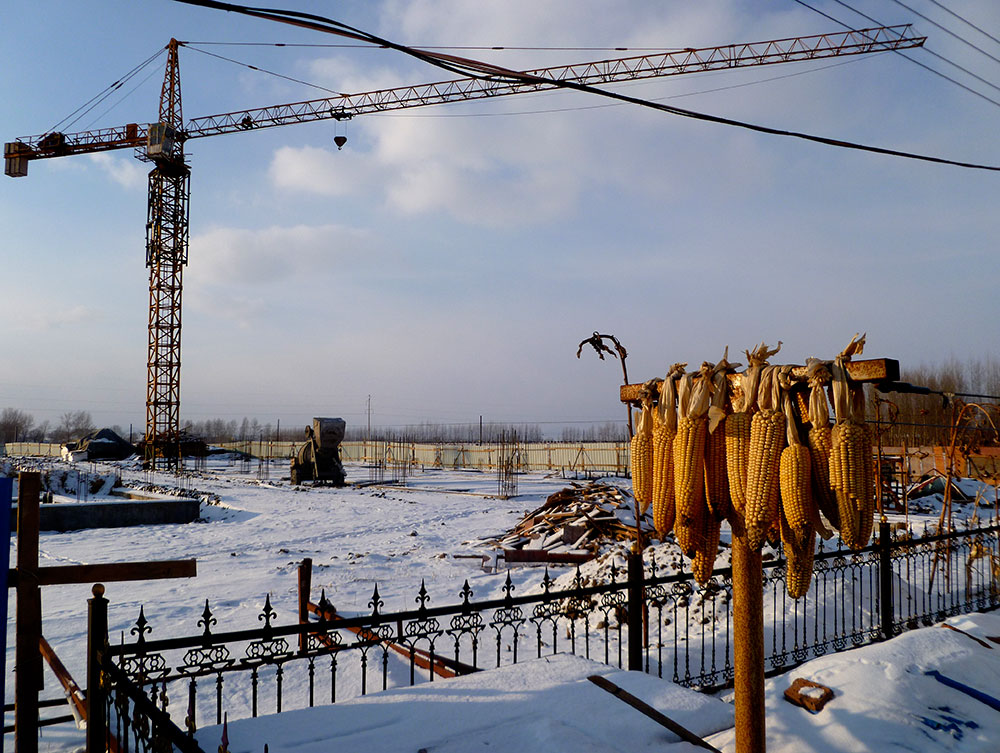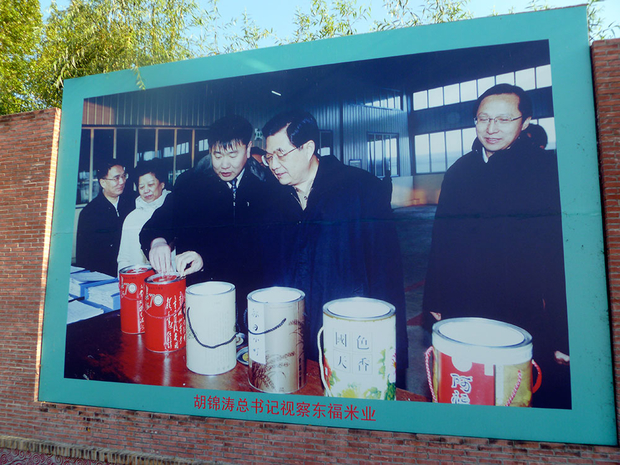In winter the land is frozen and still. A cloudless sky shines off snow-covered rice paddies, reflecting light so bright, you have to shield your eyes. I lean into a stinging wind and trudge north up Red Flag Road, to a village named Wasteland.
The view is flat, lifeless, and silver fresh. The two-lane cement road slices through the paddies like the courses plowed across frozen lakes in my native Minnesota, but there are no icehouses to shelter in here. Ten minutes ago, I set off from the coal-fueled warmth of Number 22 Middle School, where I volunteer as an English teacher. Already my beard is beaded with ice.
Culture
02.04.15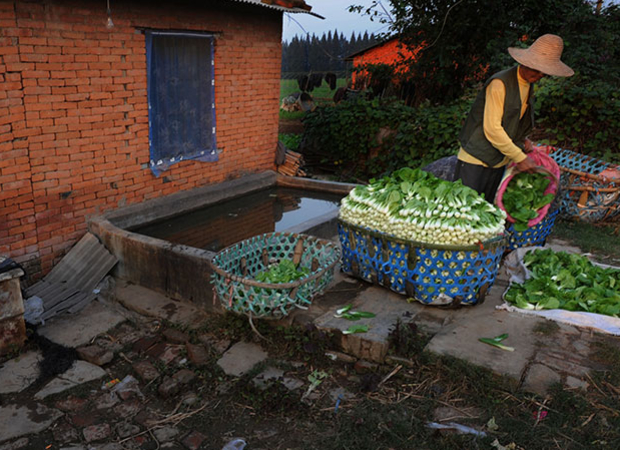
‘This is not that China Story’
Tufts of dry husks sprout through the snow, resembling ripening brooms. To my left, the sun sinks over the far horizon. It is 3:22 p.m. at December’s End—or, as Chinese farmers know it, dongzhi (Winter Solstice), one of twenty-four fortnight-long periods describing the seasons based on the sun’s longitude. The previous solar term was Major Snow, which fell on schedule, blanketing Wasteland in white. Next up, in early January, is Slight Cold, which, given today’s high temperature of minus 8 degrees Fahrenheit, makes me fear what “slight” will feel like. At school, a red nylon propaganda banner lashed to the accordion entrance gate urges us to Prevent hand, foot, and mouth disease and, less helpfully, announces that Winter brings the biggest change in temperature.
Red Flag Road’s single traffic sign displays a speed limit of forty kilometers an hour. On school days I never see anyone break it; bicycles and three-wheeled motorcycles saunter and sputter to the crossroads’ Agricultural Bank, seed store, noodle shops, and train station. Painted bright pink and crowned with a peaked tin roof whose cobalt-blue matches Wasteland’s usual sky, the station has been rendered all but obsolete: the new highspeed trains that cover the seventy miles between the cities of Jilin and Changchun do not stop here. For passengers in the sealed compartment, Wasteland whooshes by in a silent four-second blur, looking like any other village in Northeast China.
Closer inspection reveals a dotted line of trash aside Red Flag Road: empty boxes of expensive Panda brand cigarettes and bottles of Moutai brand liquor; broadsheets of stock tips, real estate flyers, and fortune-telling booklets advising the most auspicious days to buy property; and self-published circulars, sold in big cities, with titles such as Intriguing Stories and Strange Affairs. In addition to the latest gossip about the private lives of top officials, the pamphlets answer questions such as Will our capital be moved from Beijing? (No.) Did the 1989 student protest movement fail? (Yes.) How many people were killed during the Cultural Revolution? (Lots.)
Today the only sound on Red Flag Road comes from another banner, strung between two Manchurian ash seedlings, whipping in the wind. The cloth twists and unfurls, then twists again. Between gusts spin the Chinese characters for plant, then seeds, then record and yield. I pass the banner every day and, unlike the farmers, study its message. In the Chinese countryside—free of newsstands and street signs—propaganda is my primer, even when written by Comrade Obvious. This red ribbon teaches me the characters that form: Plant quality seeds to produce a record yield.
For decades, the three-story middle school was Wasteland’s tallest structure. From my English classroom window I can see all the village’s homes, whose clusters make an archipelago across the fields. Now I walk toward a billboard whose message I can read a mile away: Build the Northeast’s Top Village. It was erected by Eastern Fortune Rice, a private agribusiness company based in Wasteland. I never thought about this propaganda—just another exercise in blatancy—until Eastern Fortune began making it come true.
Gossip says that, like the railroad, Red Flag Road will be upgraded, too. Locals wonder if it’s their way of life that will be made obsolete. There’s even talk of changing the village’s name.
No one can say for certain why the place is called Wasteland. It may have been a ploy by homesteaders to discourage other migrants from moving to this fertile floodplain, stretching from the western banks of the Songhua (Pine Flower) River to forested foothills. Neighboring hamlets, also comprising a few dozen single-story homes abutting table-flat rice paddies, include Lonely Outpost, Zhang’s Smelly Ditch, the Dunes, and Mud Town. In the movie Caddyshack, Rodney Dangerfield boasts that he and his partner, Wang, just bought some land at the Great Wall: “On the good side!” Wasteland is in the other direction. Beyond the wall begins China’s northeast, or Dongbei (rhymes with wrong way). Chinese say a map of their country resembles a chicken, which makes the Northeast its head, squeezing between Mongolian grasslands and the Ever-White Mountains before bumping up against Siberia.
Postcard
06.06.12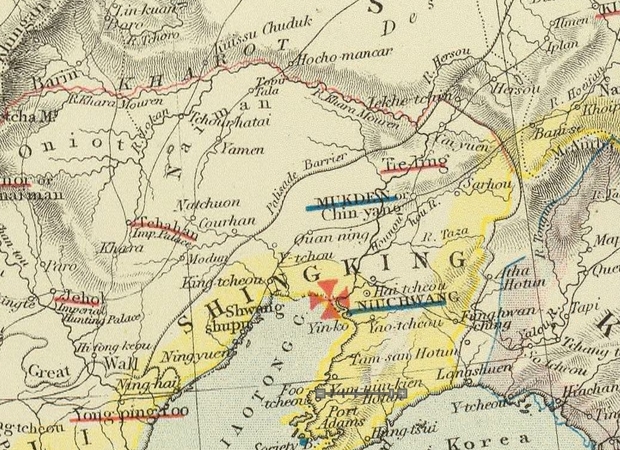
The Lesser Wall
Perhaps no other region has exerted more influence on China across the last four hundred years. Historically, the West referred to the Northeast as Manchuria, homeland of the Manchu, tribes that for centuries alternated between independence from and vassalage to the Chinese emperor before uniting to storm through the Great Wall in 1644 and seize the Beijing throne. The Manchu’s Qing dynasty ruled China for nearly three hundred years, doubling its territory—adding Tibet, Xinjiang, and Inner Mongolia—to form the borders of today’s multiethnic nation. But the regime’s center could not hold. On her deathbed in 1908, the Empress Dowager Cixi chose a two-year-old boy named Puyi for the throne. The toddler bawled during his coronation. “Don’t cry,” his father consoled. “It will be over soon.” Four years later, the increasingly dissolute Qing crumbled, and Puyi became China’s last emperor, forced to abdicate in 1912 after the revolution led by Sun Yat-sen that created the Chinese republic.
By then, the nation’s gains were the Manchu’s loss: more Manchu lived south of the Great Wall than in their former homeland, and culturally they had all but assimilated with the Han Chinese they once ruled. Today, most Manchu look indistinguishable from other Northeasterners. Though their court was bilingual—Mandarin remained China’s lingua franca; a Manchu emperor even named Tiananmen, Chinese for “the Gate of Heavenly Peace”—most Manchu no longer spoke their mother tongue. The language, which sounds nothing like Mandarin and is written in a Mongolian-based script, began a fade toward extinction.
Eroding, too, was the Manchu’s hold on the Northeast, which their emperors had attempted to maintain as a cultural reserve. Countermanding centuries of edicts restricting migration to Manchuria, Han Chinese homesteaders flooded the region. Between 1927 and 1929 alone, an estimated one million settlers arrived each year, surpassing the number of Europeans who landed annually in the United States at the peak of its immigration wave.
Most new arrivals didn’t call the land Manchuria, or the Northeast, or “east of the barrier” (the Great Wall), or even the “three eastern provinces,” as redistricting had it rendered on maps. They called their new home what it looked like: the Great Northern Wasteland.
“Although it is uncertain where God created paradise,” wrote a French priest crossing Manchuria during this era, “we can be sure He chose some other place than this.”
But I found it beautiful and unique, a land worthy of its evocative names.
The wind whips across the scalloped snow, slashing through my four layers of clothes. I imagine the gale born to neglectful parents named Gobi Frost and Siberian Tundra. My neighbors call their seething offspring the Torturer, constantly driving needles into our bones no matter how much we pad them.
And yet, the sky stretches from horizon to horizon, a fresh prairie sky without pause. In Chinese cities you do not stop to appreciate the sky; you can rarely see it through the smog. Other parts of rural China feel stooped and low ceilinged, with clouds sagging from age. But at China’s Northeastern frontier, the sky’s incandescent blue is as much of the landscape as the dark earth below. Farmers here seldom call the dirt mere “soil.” Unlike elsewhere in China, where fields have been turned and tilled for thousands of years, in the Northeast they farm comparatively virgin “black earth” using “sweet water.” When thawed, a handful of loam feels as rich and saturated as spent coffee grounds.
Wasteland is a typical rural Chinese community, even if its fields are not. Instead of working terraced hillsides year-round, farmers harvest a single annual crop of rice from paddies that run to the distant foothills, surrounding us on three sides.
Beijing is a twelve-hour train ride southwest, a trip equal in distance to the six-hundred mile journey between central Maine and Washington, D.C. Wasteland is closer—by half—to Vladivostok and Pyongyang, if logistical and cultural worlds away.
China’s Northeast is equal in population and area to Germany and France combined. The analogy also evokes its recent past: while late-nineteenth-century Western travelers who journeyed to Manchuria compared this frontier to Alaska’s, the next generation wrote that they had arrived in a “cradle of conflict” that was Asia’s Alsace-Lorraine.
For the first half of the twentieth century, Manchuria was the prize in battles between China, Japan, and Russia. Brokering the end of one war earned President Theodore Roosevelt the Nobel Peace Prize but gave Japan control of much of Manchuria’s railroad—China’s longest and most lucrative—linking its mineral-rich heartland to Pacific Ocean ports. Russia had failed to yoke Manchuria to eastern Siberia; Japan tried shaping it into the toehold for its imperial dream of the “Greater East Asia Co-Prosperity Sphere.”
Due to its similarity to Manchukuo, the name of the puppet state Japan founded here in 1931, the term Manchuria fell from use after Japan’s surrender, ending the Second World War. But Manchuria long predates the Japanese invasion, appearing on nineteenth-century Chinese maps and in European atlases—often replacing Tartary. Even the Communist Party’s regional office once used it, in publications with names such as the Manchurian Worker.
Western press reports revived the term during the Korean War, but Manchuria faded from use after Soviet advisers withdrew from the region in 1955 and it was—at last—wholly controlled by the central government in Beijing.
But as its status as geopolitical hot spot dimmed, the Northeast still retained its Otherness. China is a patchwork of places as diverse as America’s, each with its own local language, cuisine, and character. Append Dongbei (Northeast) before any of these nouns, and it will, to a Chinese person, evoke a ringing lilt of elongated vowels, sour cabbage served with potatoes and boiled pork dumplings, and tough, yet self-effacing, people known for eccentricity. A recent national pop hit, “All Northeasterners Are Living Lei Fengs,” poked fun at the natives’ overcompensating virtuousness, familiar to anyone who has experienced the placating temperament known as “Minnesota Nice.”
I’m attracted to all of this, especially the eccentrics, who remind me of my childhood neighbors. And unlike in China’s other borderlands, where the native mother tongue is Tibetan, Uighur, or Cantonese, the Northeast today uses standard Mandarin Chinese—which I speak and read fluently—and a closely related dialect. But it was the region’s history that drew me here most.
Chinese civilization, as my middle school students have been taught to recite with stentorian solemnity, “has five thousand years of history.” In their textbooks, the Northeast claims only a sliver of that time line, making its past feel comparatively intimate. The bulk of its recorded antiquity began in the early seventeenth century, around the time—on the other side of the world—that Shakespeare wrote his plays and the Pilgrims landed at Plymouth Rock.
Anyone who has spent time in contemporary China knows the feeling of traditions slipping away, of old landscapes remade. In Beijing you could return to a neighborhood where you ate noodles the week before and find it flattened to a field of rubble. A decade ago, at a Buddhist nunnery that would be submerged by the Three Gorges Dam, I met an elderly novitiate who said she wanted to live there forever. She asked if I could put her into a story so she always would.
Postcard
10.19.12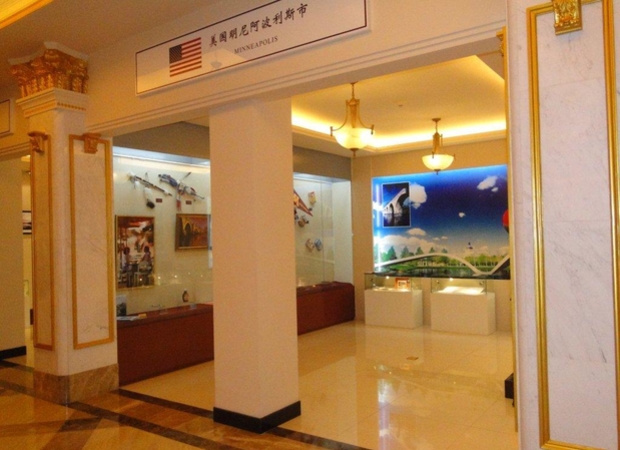
Desperately Seeking City
But the Northeast’s history still seems near. Its artifacts spill across the region like playing pieces left on a board game named Empire. You can travel on railways built in the name of the czar; pace not through ancient Buddhist temples but into onion-domed Russian Orthodox cathedrals; walk down boulevards lined with Japanese pines and colonial ministries constructed in an architectural style dubbed Rising Asia; tour Puyi’s “Puppet Emperor’s Palace”; visit sites where the Japanese held Allied prisoners, including Bataan Death March survivors; and stand on the bridge—reaching halfway across the Yalu River, separating China and North Korea—that American pilots dive-bombed during the Korean War. I saw these sites—and the stories missing from their official plaques—as markers that charted the rise and fall of the Manchu, and the nadir and ascent of modern China. Uniquely for a Chinese region, foreigners played a prominent role on its stage. Other than Harbin city’s famous Ice Lantern Festival, a month-long winter carnival around life-size replicas of famous buildings made from blocks of frozen Songhua River water, the Northeast remained to most Chinese “the land beyond the pale,” as the expanse north of the Great Wall was historically known. Winter is the barrier today; skiers and masochists aside, who sets off for a subzero holiday. Summers are mild and bright, but even then I often feel like I have this upper-right-hand corner of the nation to myself: no scrums at train ticket windows, no need for hotel reservations, no dodging tour groups. On the twenty-five thousand miles that I’ve traveled on side trips from Wasteland, I’ve often sat alone in a train car, unlike in the south, where the compartments could be so crowded I have spent rides standing in the toilet or lying on newspapers spread beneath the bench seats.
At Manchuria’s de facto border, the First Pass Under Heaven—where the Great Wall tapers into the Bohai Sea—a rebuilt section of the wall extends five hundred yards west before ending abruptly at a cinder block barrier. It obstructs any view; the visitor is stuck facing a gray curtain of cement. But set in its middle is a normal-size door, the kind that separates rooms in an apartment. Push hard and it opens to reveal the unimproved Great Wall, crumbling and crowned by tall grasses and mature elms, scaling the mountains wild. Traveling in the Northeast feels like stepping through that door.
* * *
On a farm, weather is the fourth dimension. The icy wind burns my cheeks on Red Flag Road. Ahead, in the distance, moving closer and sputtering like a shot-up biplane, I see a three-wheel tractor. Oversize sunglasses and a white cotton surgical mask obscure the driver’s face, which is further shrouded by a fur-lined People’s Liberation Army hat. Its earflaps bounce rhythmically over the black ice. The driver honks, a limpid squawk that sounds like the tractor’s battery is conserving energy. The driver lays into it harder. One rule of the Chinese countryside is that the more peaceful the surroundings, the more noise people make.
The driver stops, and the tractor idles roughly, as if stamping its feet in the cold. I have no idea who is under the hat, those glasses. Through the face mask comes the dialect-inflected demand: “Ga ha’me’ne ni!” What am I doing? “I’m walking.”
The driver asks, in the singsong Northeastern way: “Shei jia’di’ah?”
“To whose family do you belong?” is a standard greeting here—even to a foreigner—unlike elsewhere in China, where strangers ask if you’ve eaten, or what country you’re from.
“The Guans,” I reply, naming my Manchu landlords.
“Correct!” the man laughs. “Get on!” He kicks the tractor into gear. It leaps like it’s been defibrillated.
I tuck my head behind his shoulder as the driver put-puts a mile north, turning off Red Flag into a huddle of two dozen single-story brick homes.
He stops at the last one, with sodium lights shimmering through the windows and a stream of smoke flowing from its chimney. My house is another mile north, but tonight is the weekly meal with my closest friend in Wasteland.
I thank the unknown driver, who won’t accept payment, though I know that one day he will identify himself and the favor I can return. I push open the never-locked front door, stomping the snow off my jeans in the vestibule, then opening a door to the home’s main room and climbing on the kang, a brick platform bed two feet high that runs the length, and nearly the width, of the room. Heated by burning dried rice stalks, the kang’s linoleum covering is hot to the touch but feels comfortable when covered with cotton bedrolls. The house smells pleasantly of toasted grain, like we’re lounging atop baking bread, and I am always happy to step over its threshold.
Next to the kang is a round table laden with steaming plates of twice-cooked pork, flash-fried mushrooms, garlic-sautéed wild greens, and rice grown in the paddy just outside these wall-size windows, weatherproofed with plastic wrap. The dishes have been cooked in a large wok sunk into a cement stove, fired by burning rice stalks.
“Mai’er,” the family’s patriarch says with a nod.
“San Jiu,” I say, nodding back. The lack of formality—of You must be cold; have you eaten? you’re not wearing enough layers; eat; take a smoke; drink some tea; you must be cold, it’s winter now and cold outside, you have to wear more; eat; have some beer; you look cold; eat, eat, eat—means that I’m home.
“I cooked,” he says. “It’s the two of us tonight. Everyone else had to go to”—and here he says the term for Fourth Cousin, Second Nephew, or some other title which I can never keep straight without a diagram. Every branch of a Chinese family tree has its own name indicating not only which side you come from but in what order. In English we say aunt, but in China she was, for example, the wife of my father’s oldest brother. One’s cousin could be your mother’s younger sister’s second-born son. San Jiu (pronounced San Joe) means “Third Uncle on Mother’s Side.”
I know his given name, but have always called him San Jiu. He is a sixty-six-year-old ruddy-cheeked man who never seems to age but rather hardens, like the Manchuria ash lining Red Flag Road. He still opens beer bottles with his teeth, shoulders fifty-pound sacks of seed, and weeds his paddy by hand, stooping low in the muck. He smokes Changbaishan, a brand named for the perpetually snow-covered peaks on this province’s border with North Korea. The name translates as Ever-White Mountains, but when we share one together, I just see a lump of tar.
“It’s your Christmas, right?”
“In two days,” I reply.
“My wife is gone tonight,” he says, resolute. “So we can drink.”
San Jiu fills two rice bowls with Snow brand beer (often the only cups in a farmer’s home are for tea). After he finishes his bowl, he splashes in a bit of the hard stuff from a plastic gallon jug and sips loudly. None is offered: San Jiu remembers the last time he served me sorghum liquor.
That was seven years ago, when I had visited Wasteland for the first time. I was alone, on a National Geographic assignment about historical Manchuria. After rolling two hours east from the provincial capital of Changchun on a bus that smelled of feet, the driver pulled to the edge of the two-lane road, stared out the windshield into the darkness, and said, gravely: “Are you sure you want to get off here?”
After he pulled away, I stood alone in the subzero air, regretting the decision. There were no taxis, no dumpling restaurants or shops to wait inside—no streetlights, even. A calf-high granite slab said, in Chinese characters, that I had arrived in Wasteland.
With chattering teeth, I walked up Red Flag Road under a black dome thick with stars. The Big Dipper bent low over snow-covered paddies. Complete silence. Plumes of breath. The smell of burning rice stalks wafting from chimneys. San Jiu stood on the road with a flashlight, waiting. He led me to his house and into a room full of people raising glasses over a table full of steaming food.
“What if I moved here?” I had asked, after too many shots of 120-proof liquor.
“You live in Beijing!” he said. “Everyone wants to be there. No one moves here.”
But I could, I thought, keeping the notion to myself.
After dinner, San Jiu stretched me on the kang next to him. We slept side by side, as rigid as mummies. Through the night, I dreamed of moving to Manchuria.
But I had stayed in Beijing, living in the capital’s oldest neighborhood with several Chinese families in a courtyard home that lacked heat, hot water, and a toilet. Beijing was tearing down its traditional lanes—hutong—at the heart of its Old City, and before it vanished I wanted to experience a life that tourists, foreign students, and journalists (I had been, in order, all three) only viewed in passing. For two years I taught English in the local elementary school and to retired seniors, giving me a purpose and place in the community. Life in the lanes was not postcard pretty—poverty never is—as I wrote in The Last Days of Old Beijing, a book detailing the neighborhood’s layered history and daily routines. Much of what I saw on my hutong had Manchu origins, including the bamboo whistles fastened to the feet of the pet pigeons that dopplered mournfully overhead every afternoon; the names of lanes with banner in them, for a military division; the silk cheongsam (qipao, “banner robe”) dresses being hand-sewn at the tailor’s; and the Peking opera clanging at all hours on my elderly neighbor’s television.
Throughout those years, I held Wasteland in reserve. The dominant narrative of modern China is told from its capital and coastal cities. Those shiny cities! Those new cities! Those Olympics-hosting cities! Those car-choked, class-divided, and overcrowded cities! Most foreign correspondents live in cities, and Chinese writers have long focused on urbanity and urban intellectuals—one reason some contemporary Chinese scholars feel that Pearl Buck’s 1931 novel The Good Earth should be taught as Chinese literature.
I had written about change in urban China, and now I wondered how the other half lived. The sheer numbers of people moving off farms to urban centers had me picturing fields going to seed, as if farmers had tossed down their scythes to hop a passing bus and never return. I imagined empty houses illuminated by left-on televisions, and cows mooing plaintively with full udders.
In 1993, the U.S. Census stopped counting American farmers: the demographic had become “statistically insignificant,” as less than 2 percent of the population lives on a farm. But in China nearly half the country—some 700 million people—still lives in rural areas such as Wasteland. That number was plummeting: since 2000, a quarter of China’s villages had died out, victims of migration or the redrawing of municipal borders to encompass surrounding hamlets, meeting national urbanization targets. Though it sat twenty miles and an hour’s bus ride away, Wasteland was recently folded into the Jilin city limits, retaining its name and—on paper, at least—offering residents the chance to become urbanites.
I knew that in the Northeast I could explore China’s past. I didn’t expect that in Wasteland I would glimpse the nation’s future.
By 2011, China had spent more years dismantling a Marxist society than building one. Wasteland faces a new, unknown economic phase: becoming a company town.
Its largest business, Eastern Fortune Rice, began in 2000, when two village partners planted the same short-grain sticky rice as their neighbors.
The variety is commonly used in sushi, though Chinese eat it as a side dish. But unlike their hidebound neighbors, Eastern Fortune’s founders experimented. They tested different seed varieties and for the first time in Wasteland grew an organic crop.
By the third harvest, government ministries began serving the rice—branded Big Wasteland—at official banquets. In 2007, China’s then president, Hu Jintao, visited the village and Eastern Fortune’s headquarters.
A massive photo of him inspecting production hangs at the entrance to the company’s new hot spring resort, which on weekends attracts a steady stream of city day-trippers who trail the jetstream of trash down Red Flag Road. The hot spring’s 120 yuan ($20) entrance fee equals what local farmers earn in a fortnight.
Initially my neighbors were happy when the company announced it would buy their rice crop at above market prices and hire them to work the polishing and packaging machines it imported from Japan. As the company profited, so did the village. In the previous seven years, the number of farmers contracting their fields to Eastern Fortune doubled. The company provided rice seed and guaranteed payment of 15,500 yuan ($2,500) for a family’s harvest.
That figure was twice as much as the average Chinese farmer earned annually. Eastern Fortune had contracted nearly all of Wasteland’s five square miles of paddies, though a few families, including San Jiu’s, still held out.
A skyline is sprouting. At the end of Red Flag Road stand cranes and the shells of five-story walk-up buildings. Eastern Fortune is offering apartments in exchange for farmers’ homes, which will be razed and the land converted to paddies. Few have agreed to move: giving up their homes means losing a garden and chicken coop, which allows for self-sufficiency and a secondary income. It also takes many families’ homes off the land itself, contrary to the traditional belief that health emanates from “being in contact with the earth’s energy.” And the elderly are worried about climbing stairs to a third-, fourth-, or even fifth-story apartment. Lastly, moving off the land means betting that the price of rice will not skyrocket by the end of the agreement. The amount promised by Eastern Fortune was, in effect, a futures contract: what seems fair today might not seem that way next year. Grain prices, like real estate, continue to soar.
The apartment project’s multicolored, laser-printed billboard shows a purling stream, renamed the Revere Gentry River, an incongruously feudal term for a collectively owned farming community. Its rendition is crowned with lotuses and bordered by willow trees and apartments with indoor plumbing and central heat. The people in this future scene sit on benches and stroll under trellises with children and lovers wearing blouses and skirts and T-shirts and jeans. They look and act nothing like Wastelanders. At least, not yet.
The kang’s heat has me peeling layers of clothing, and San Jiu’s cheeks are pink from the lukewarm Snow beer, bottles of which he pulls from a plastic crate beneath the round table. I dread a run outside to the toilet.
When San Jiu goes first, I notice a book atop the bureau, titled Farmer Lawsuits. It contains three hundred answers to questions that include Can the village committee profit from individual farmers’ land? (No.); Does the village committee have to make its books open to the public? (Yes.); Is it true that hitting one’s wife and child is the home’s concern, not the village’s? (No.); and Do farmers have the right to petition the national government? (Yes.). I am half expecting to read Does winter bring the biggest change in temperature? when San Jiu returns and says, “That book wasn’t so useful. I knew all of that.”
He switches on the television, showing the national broadcast of the 7:00 news. We sit with shoulders touching on the kang. One of the lead reports details the government’s measures to rein in inflation. As it does every week at our shared meal, the mention of money leads San Jiu to ask me the price of gasoline in the United States. “What about pork? A bottle of corn oil?” For the next half hour we recount the cost of garlic, the cost of chives, the amount for tuition, the cost of rent. Everything is up, he says.
“Including the price of rice,” I say. “That’s good for you.”
“Seed is up, fuel is up, water is up, electricity is up. It’s funny that the only thing that’s gone down is taxes.”
In 2006, for the first time in its history, China abolished all taxes on farmers.
The landline telephone rings. San Jiu lifts the receiver. His side of the conversation sounds like this:
[Ring] Uh!
Uh?
Uhhh.
Uh. [Click]
There is no Chinese character for Uh, but in the Northeast it stands for many. It can mean Hello; Good-bye; I hear you; I agree; More, please; and This is a difficult question to answer simply. San Jiu turns his attention back to the evening news. He tells me that someone is coming to join us. I don’t recognize the noun describing the man’s place on the family tree, and San Jiu explains it slowly, in the same tone I use when diagramming a complex sentence on the blackboard for my middle school students.
“He is the son. Of the stepbrother. Understand? Of your mother-in-law. Of your wife’s mother. Is it clear?”
“Uh.”
And therein lies the truest answer to the question of what really led me to Manchuria, and to—of all the Northeast’s villages—Wasteland. Not, initially, because of an intrinsic attraction to its history and ways. That gripped me over time. The root attraction was much simpler: a girl.
Excerpts
08.10.15